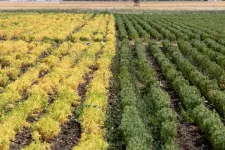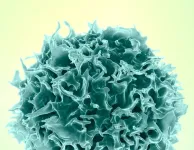(Press-News.org) An international research collaboration has completed the most detailed genome assembly to date of grass pea (Lathyrus sativus).
This new chromosome-scale reference genome published in Scientific Data offers new potential to accelerate modern breeding of this underutilised legume for climate-smart agriculture.
Nearly twice the size of the human genome, the sequence was assembled from scratch and improves on an earlier draft assembly of the vigorous grass pea line LS007.
“We want to establish this new genome sequence as the reference genome for the grass pea community, and we’re delighted to share this valuable resource for other scientists to use and learn about grass pea,” explained corresponding author of the research Dr Peter Emmrich, a researcher at Norwich Institute for Sustainable Development (NISD) and visiting group leader at the John Innes Centre.
“At a time of increasing weather shocks, this genome allows us to unlock the secrets of grass pea’s resilience, to further improve this crop for farmers, and inform development of other crops, such as peas,” he added.
Improvements in genome accuracy and completeness also allow researchers to study evolutionary links between species, helping identify gene pathways that could be used to improve the crop or to understand its remarkable drought tolerance.
Dr Anne Edwards, research assistant at the John Innes Centre, said: “As we prepare for a future of increased climate change, we are going to need crops that can cope with drought, or flooding or inundations of salt water. This new genome sequence means that we are even closer to adding grass pea to the list of climate-smart crops of tomorrow. It’s an exciting time to be in the grass pea research community!”
What is Grass Pea?
Grass pea is a crop grown in many regions of the world that is high in protein and resilient to drought and flooding. One of the oldest known cultivated plants, grass pea is now grown in Ethiopia, Eritrea, India, Bangladesh, and Nepal. It has been used for centuries as an insurance crop, that survives when other crops fail and is safe to eat as part of a balanced diet.
Grass pea is among a group neglected and underutilised crops that play a key role in local nutrition and livelihoods, but that historically have received little attention from breeders and researchers. However, its resilience to both drought and flooding makes it a promising crop for ensuring food security in a changing climate.
Grass pea’s widespread cultivation has been hampered due to a toxin contained within its seeds and shoots, which can, in malnourished people, cause the disease neurolathyrism, a condition which causes irreversible paralysis.
Another major barrier preventing crop breeding improvements was the lack of a genome reference for the crop.
The availability of the new genome sequence means researchers could use gene editing and modern breeding methods to develop varieties of grass pea with improved agronomic characteristics or low or zero toxin content. This means that grass pea could be poised to make an important contribution to a more diversified and climate resilient food system in the future.
END
A new piece in the grass pea puzzle - updated genome sequence published
2024-10-31
ELSE PRESS RELEASES FROM THIS DATE:
“Wearable” devices for cells
2024-10-31
CAMBRDIGE, MA – Wearable devices like smartwatches and fitness trackers interact with parts of our bodies to measure and learn from internal processes, such as our heart rate or sleep stages.
Now, MIT researchers have developed wearable devices that may be able to perform similar functions for individual cells inside the body.
These battery-free, subcellular-sized devices, made of a soft polymer, are designed to gently wrap around different parts of neurons, such as axons and dendrites, without damaging the cells, upon wireless actuation with light. By snugly wrapping neuronal processes, they could be used to measure ...
Cancer management: Stent sensor can warn of blockages in the bile duct
2024-10-31
Images
Stents to treat various blockages in the human body can themselves become blocked, but a new sensor developed at the University of Michigan for stents that are used in the bile duct may one day help doctors detect and treat stent blockages early, helping keep patients healthier.
Bile duct blockages can cause jaundice, liver damage and potentially life-threatening infections. Conditions that cause the bile ducts to narrow and close, including pancreatic and liver ...
Nov. 14 AARP Author Q&A at GSA 2024 in Seattle: Debra Whitman, Global Aging Expert and Author of ‘The Second Fifty: Answers to the 7 Big Questions of Midlife and Beyond’
2024-10-31
Author Q&A: Debra Whitman, Global Aging Expert and Author of “The Second Fifty”
Date: Thursday, November 14
Time: 4:30 to 5:30 p.m. PT
Location: Seattle Convention Center Arch Building Room 305
Registration: GSA 2024 Annual Scientific Meeting media registration is required to attend this event.
During this meet-the-author media roundtable, Debra Whitman, executive vice president and chief public policy officer at AARP, will discuss her new book, “The Second Fifty: Answers to the 7 Big ...
Autistic psychiatrists who don't know they're autistic may fail to spot autism in patients
2024-10-31
Groundbreaking research exploring the experiences of autistic psychiatrists has revealed that psychiatrists who are unaware that they themselves are autistic may fail to recognise the condition in their patients. The study, conducted by researchers from University College Dublin, London South Bank University, Brighton and Sussex Medical School, is the first of its kind to delve into the lives of neurodivergent psychiatrists. It was published today in BJPsych Open.
"Knowing that you are autistic can be positively life-changing," said the study author Dr Mary Doherty, Clinical Associate ...
New findings on animal viruses with potential to infect humans
2024-10-31
COLUMBUS, Ohio – Scientists investigating animal viruses with potential to infect humans have identified a critical protein that could enable spillover of a family of organisms called arteriviruses.
In a new study, researchers identified a protein in mammals that welcomes arteriviruses into host cells to start an infection. The team also found that an existing monoclonal antibody that binds to this protein protects cells from viral infection.
Arteriviruses circulate broadly in many types of mammals around the world that serve as natural hosts – such as ...
Ancient rocks may bring dark matter to light
2024-10-31
The visible universe — all the potatoes, gas giants, steamy romance novels, black holes, questionable tattoos, and overwritten sentences — accounts for only 5 percent of the cosmos.
A Virginia Tech-led team is hunting for the rest of it, not with telescopes or particle colliders, but by scrutinizing billion-year-old rocks for traces of dark matter.
In leading a transdisciplinary team from multiple universities on this unconventional search, physics’ Patrick Huber is also taking an unconventional step: from theoretical work into experimental work.
With support from a $3.5 million Growing Convergence Research ...
Study reveals acceleration in Pacific upper-ocean circulation over past 30 years, impacting global weather patterns
2024-10-31
A new study published October 31, 2024, in the Journal of Geophysical Research: Oceans has revealed significant acceleration in the upper-ocean circulation of the equatorial Pacific over the past 30 years. This acceleration is primarily driven by intensified atmospheric winds, leading to increased oceanic currents that are both stronger and shallower, with potential impacts on regional and global climate patterns, including the frequency and intensity of El Niño and La Niña events. The study provides a spatial view of these long-term trends from observations, adding at least ...
Virginia Tech researcher finds AI could help improve city planning
2024-10-31
Traditional city planning methods require significant technical expertise and manual work.
A Virginia Tech researcher is working to change that.
New research shows the potential of large language models (LLMs), such as ChatGPT and Google’s Gemini, for assessing the human-made environment using street-view images.
By comparing LLM performance with traditional city planning deep learning methods, the study from the College of Natural Resources and Environment found that LLM-based performance is similar with established approaches. Unlike ...
A trick of light: UC Irvine researchers turn silicon into direct bandgap semiconductor
2024-10-31
Irvine, Calif., Oct. 31, 2024 — By creating a new way for light and matter to interact, researchers at the University of California, Irvine have enabled the manufacturing of ultrathin silicon solar cells that could help spread the energy-converting technology to a vast range of applications, including thermoelectric clothing and onboard vehicle and device charging.
The development, subject of a paper recently published as the cover story in the journal ACS Nano, hinges on the UC Irvine researchers’ conversion of pure silicon from an indirect to a direct bandgap semiconductor through the way it interacts ...
NIH trial of rectal microbicide for HIV prevention begins in the United States
2024-10-31
WHAT:
A clinical trial sponsored by the National Institutes of Health (NIH) has launched to examine the safety and acceptability of a novel rectal HIV microbicide douche containing the antiretroviral drug tenofovir. This “on-demand” HIV prevention approach involves using the microbicide prior to a potential exposure from receptive anal intercourse.
Several forms of HIV pre-exposure prophylaxis (PrEP) are in use in the United States and globally, namely daily oral pills, long-acting injections, and a monthly vaginal ring. The Centers for Disease Control and Prevention advises that gay, bisexual and other men who have sex with ...






